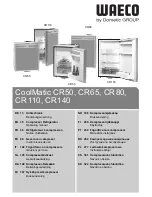
Freezing foods / storing frozen foods
Page EN-16
Suitable packaging
Packaging is important when freezing. This
will protect against oxidation, penetration by
microbes, transfer of odours and flavourings
and drying out (freezer burn).
• Only use packaging material that is
strong, impermeable to air and liquid, not
too stiff and labelled. It should be desig-
nated as suitable for freezer use.
Portions
• Create flat portions if possible; these
freeze through to the core faster.
• Expel the air from the freezer bag as this
causes the contents to dry out and takes
up space.
• Use plastic clips, rubber bands or adhe-
sive tapes to seal.
• Fill liquid containers no more ¾ full, be-
cause liquids expand when frozen.
• Do not store glass or metal containers of
liquid. These containers could break.
• Only freeze high-proof alcohol that is
tightly sealed.
• Label the frozen food by type, quantity,
freezing and expiry date. Use waterproof
marker pens or adhesive labels wherever
possible.
Freezing food
• Adhere to the maximum freezing capacity.
You will find information about ‘Freezing
capacity in kg/24 hours’ in the data sheet
on page EN-30.
• Once the freezer temperature is -18 °C,
you can freeze fresh, room-temperature
foods.
• Keep fresh goods out of contact with ex-
isting frozen foods as they could start to
thaw. If contact with stored food cannot
be avoided, we recommend that you cre-
ate a cold reserve in the freezer compart-
ment before freezing the fresh goods.
The temperature in the freezer compartment
will rise briefly after you place fresh goods
inside. After 24 hours, the goods are frozen
to the core.
Storing frozen food
The cold chain must not be broken at any
point between the food retailer and your
freezer compartment. The temperature of the
frozen food must always be at least -18° C.
Therefore, do not buy any goods that
– are in frosty, over-icy chests.
– are stacked above the stipulated high-load
marker.
– partially clumped (particularly easy to iden-
tify with berries and vegetables).
– have snow and juice traces.
Transport frozen foods in special styrofoam
boxes or insulated bags.
Observe the information on storage condi-
tions and times provided on the food pack-
aging.
Defrosting food
Observe the following basic rules when de-
frosting food:
– To defrost food, remove it from the freezer
compartment and let it defrost at room tem-
perature or in the refrigerator.
– To defrost food quickly, use the defrost
function on your microwave, for example.
Observe the manufacturer’s instructions
and note that bacteria and germs can form
in this way.
– Cook or use thawed foods as soon as pos-
sible.
– Dispose of the defrosting liquid.
Summary of Contents for HEKS 12254GA2
Page 64: ......
















































